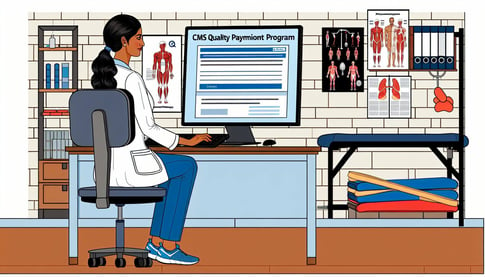August 19, 2024
What Is the Quality Payment Program in Physical Therapy?
Payment models are continually shifting to ensure that quality, rather than quantity, becomes the cornerstone of reimbursement. As physical therapy professionals and practice owners, staying informed about these changes is crucial for maintaining a successful practice. One of the most significant shifts in recent years has been the introduction of the CMS Quality Payment Program (QPP), which fundamentally changes how clinicians are reimbursed for Medicare Part B services.
What is the CMS Quality Payment Program?
The Quality Payment Program (QPP), introduced under the Medicare Access and CHIP Reauthorization Act (MACRA) of 2015, represents a critical move away from the flawed Sustainable Growth Rate (SGR) formula. This program is designed to reward healthcare providers, including physical therapists, for delivering high-quality care rather than merely increasing the volume of services provided. The CMS QPP offers a streamlined approach to value-based care, allowing clinicians to earn bonuses or face penalties based on their performance.
The Two Paths of the CMS QPP
The QPP CMS framework provides two primary pathways for clinicians to participate in value-based reimbursement:
- Merit-based Incentive Payment System (MIPS)
- Advanced Alternative Payment Models (APMs)
1. Merit-based Incentive Payment System (MIPS)
MIPS is the most commonly used pathway within the CMS QPP. It combines elements from previous programs, such as the Physician Quality Reporting System (PQRS), the Value-based Payment Modifier (VM), and the Medicare Electronic Medical Record Incentive Program, into a single performance-based platform. For physical therapists, MIPS measures performance across four key areas:
- Quality: This category replaces PQRS and assesses the quality of care provided to patients. For physical therapists, this might involve tracking patient outcomes, adherence to treatment plans, and patient satisfaction.
- Promoting Interoperability: This focuses on the use of electronic medical records (EMRs) to improve patient care. Interoperability is crucial in ensuring that patient information is easily shared among different healthcare providers, leading to better-coordinated care.
- Cost: This measures the cost of care provided. The goal is to reduce unnecessary spending while maintaining high-quality care. For physical therapists, efficient use of resources without compromising patient outcomes is key.
- Improvement Activities: This category rewards clinicians for engaging in activities that improve clinical practice, such as care coordination, patient safety, and patient engagement.
Each of these areas contributes to a total score out of 100 points, which determines the payment adjustment you’ll receive. To avoid penalties, a score of at least 75 points is required. The quality incentive payment program within MIPS allows physical therapists to receive positive adjustments to their payments if they exceed the performance threshold.
2. Advanced Alternative Payment Models (APMs)
For those physical therapists and practice owners who are looking to engage in more innovative payment models, Advanced APMs offer another path within the QPP CMS. APMs provide incentive payments for providing high-quality, cost-efficient care. These models often apply to specific conditions, care episodes, or patient populations.
Advanced APMs are risk-based, meaning that clinicians share in the financial risk of the model. If the cost of care is reduced while maintaining or improving quality, the provider can earn additional payments. However, if costs exceed benchmarks, providers may face financial losses. This path is less common in physical therapy due to the complexity of risk-sharing arrangements, but it offers significant potential for those who can effectively manage these challenges.

Why the Quality Payment Program Matters for Physical Therapists
The transition to value-based care under the CMS Quality Payment Program has significant implications for physical therapy practices. As a practice owner, you must understand how these changes impact your reimbursement and the overall financial health of your practice. Here are some reasons why the QPP is particularly important for physical therapists:
-
Focus on Patient Outcomes: The QPP emphasizes the quality of care, which aligns with the core values of physical therapy. By focusing on outcomes, you can ensure that your patients receive the best possible care while also improving your practice’s financial performance.
-
Financial Incentives: The quality incentive payment program within the QPP provides financial rewards for high-performing clinicians. By meeting or exceeding performance thresholds, you can earn bonuses that boost your revenue.
-
Avoiding Penalties: Non-participation or poor performance in the QPP can lead to significant financial penalties. By understanding the requirements and actively participating in the program, you can avoid these penalties and ensure a stable income stream for your practice.
-
Improved Practice Efficiency: The focus on interoperability and cost-efficiency encourages practices to adopt more efficient processes and technologies. This can lead to better patient care and reduced operational costs in the long term.
Making the CMS Quality Payment Program Easier and More Streamlined
Navigating the QPP CMS can seem daunting, especially given the complexities of MIPS and APMs. However, there are several strategies that physical therapists and practice owners can implement to make participation easier and more streamlined.
1. Leverage Technology for Reporting and Interoperability
One of the most significant challenges in the QPP is meeting the reporting requirements, particularly in the Promoting Interoperability category. Investing in robust EMR systems that support seamless data sharing and reporting can significantly reduce the administrative burden. Ensure that your EMR system is fully integrated with the necessary tools for capturing and reporting MIPS data accurately.
2. Focus on High-Impact Measures
The Quality category within MIPS offers a wide range of measures to choose from. To maximize your score, focus on the measures that have the most significant impact on your practice. For physical therapy, this could include measures related to functional outcomes, patient satisfaction, and adherence to evidence-based practices. By selecting measures that align closely with your practice’s strengths, you can improve your performance and increase your chances of receiving positive payment adjustments.
3. Engage in Improvement Activities
The Improvement Activities category is an area where many physical therapy practices can excel. These activities often involve improving patient engagement, care coordination, and safety—areas that are already a focus in many practices. By documenting and reporting these activities, you can earn points that contribute to your overall MIPS score. Consider implementing patient education programs, improving care coordination with other healthcare providers, and adopting new safety protocols to enhance your practice’s performance in this category.
4. Stay Informed and Educated
The landscape of the CMS QPP is continually evolving, with new rules and updates being released regularly. Staying informed about these changes is crucial to ensure compliance and optimize your performance. Regularly review updates from CMS and consider participating in webinars or training sessions focused on QPP CMS. This will help you stay ahead of the curve and adapt to any changes in the program.
5. Consider Professional Support
If the complexities of the QPP seem overwhelming, consider seeking professional support. Healthcare consultants and third-party service providers can offer guidance and assistance in navigating the program. They can help you with everything from selecting the right measures to optimizing your practice’s performance and ensuring accurate reporting.

How Physical Therapy Software Like PtEverywhere Can Help
Physical therapy software like PtEverywhere can significantly streamline your participation in the CMS Quality Payment Program. With its comprehensive features, PtEverywhere supports your practice in several key areas:
-
Efficient Reporting: Automatically track and report quality measures, ensuring accurate and timely submission to CMS.
-
Enhanced Interoperability: Seamlessly integrate with other healthcare systems, making it easier to share patient data and meet interoperability requirements.
-
Improvement Activities: Utilize built-in tools to implement and document improvement activities, boosting your MIPS score.
-
Patient Engagement: Improve patient communication and engagement through user-friendly patient portals and telehealth options, contributing to better outcomes and higher performance scores.
By leveraging PtEverywhere, you can simplify the complexities of the QPP and focus on providing high-quality care.
Conclusion
The CMS Quality Payment Program is a significant shift in how healthcare providers, including physical therapists, are reimbursed for Medicare Part B services. By focusing on quality and value rather than volume, the QPP CMS aims to improve patient care while controlling healthcare costs. For physical therapy professionals and practice owners, understanding and participating in the QPP is essential for maintaining financial stability and ensuring the continued success of your practice.
By leveraging technology, focusing on high-impact measures, engaging in improvement activities, staying informed, and seeking professional support when necessary, you can navigate the QPP with confidence. The quality incentive payment program offers both opportunities and challenges, but with the right approach, you can turn these changes into a competitive advantage for your practice.
Staying proactive and informed about the CMS Quality Payment Program will not only help you avoid penalties but also position your practice for success in the evolving healthcare landscape.


